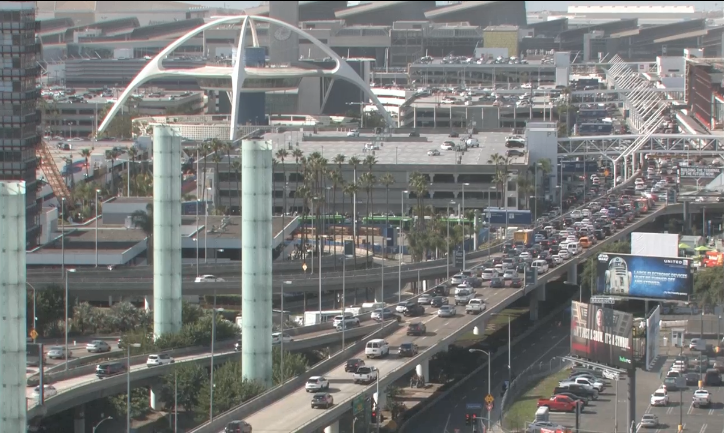For years, U.S. airports have lagged behind their international counterparts. Aging terminals, inefficient layouts, and poor public transportation access have made travel through major hubs a frustrating experience. While the busiest airport in the U.S., Hartsfield-Jackson Atlanta International (ATL), has expanded thanks to available land, major metropolitan airports like Los Angeles International Airport (LAX) don’t have that luxury.
Updating airports is expensive and causes major disruptions to an airport’s operations. Facing these challenges, the U.S. is catching up, with major investments in airport infrastructure in our largest cities, including the $8 billion revamp of LaGuardia (LGA) and ongoing improvements at John F. Kennedy (JFK). LAX, one of the country’s busiest airports and a key gateway to the Pacific, is also undergoing a massive transformation.
The Biggest Problem: LAX’s Horseshoe Layout

One of LAX’s most notorious issues is its horseshoe-shaped terminal configuration, which creates a constant bottleneck for both vehicle and passenger flow. Unlike airports with a central terminal design, LAX’s layout forces traffic into a confined loop, leading to congestion, delays, and frustration for travelers. Previous efforts to address these issues have been largely ineffective, but a $30 billion modernization plan is now in progress to fix LAX’s biggest pain points.
A key component of this plan is the long-overdue introduction of an automated people mover (APM). This project aims to improve connectivity between terminals and reduce dependency on shuttle buses, which currently add to the airport’s traffic woes. However, with the 2028 Olympics approaching, the question remains: will these improvements be completed in time?
LAX has introduced measures to ease traffic congestion in the horseshoe, though ongoing construction has exacerbated the issue. One example is the LAX-it lot for taxis and rideshares. However, with limited transportation options within the airport, most passengers are required to take a shuttle bus to the lot.
For a deeper dive into LAX’s transit challenges and modernization efforts, check out this video. It goes into how LAX can try to fix the current problems but also how the airport’s design provides challenges to expand capacity.
The Experience of Traveling Through LAX
In our experience, LAX has been a connection point for flights to Hawaii and Asia. However, many passengers either begin or end their journeys here, increasing congestion at terminals and along roadways leading to the airport. Unlike travelers at other major airports who benefit from a well-connected public transportation system, those at LAX have historically had few options beyond expensive rideshares, rental cars, or hotel shuttles.
Because of these challenges, many locals actively avoid LAX when possible, opting for smaller airports like Hollywood Burbank (BUR) or John Wayne Airport in Orange County (SNA). These alternatives offer a less stressful experience, with shorter lines, easier parking, and more manageable traffic.
The Lack of Public Transportation
One of the biggest factors worsening congestion at LAX is its lack of efficient public transit access. While many world-class airports have seamless connections to metro systems, LAX has long been an outlier. The long-promised LAX Transit Connector, designed to link the airport with LA Metro’s rail system, is in development, but its effectiveness remains to be seen. Will it be enough to alleviate the congestion issues?
Some of the problems at LAX are not entirely the airport’s creation. Los Angeles is fundamentally a car-centric city, which makes public transportation a challenge across the region. LAX has to accommodate this reality by not only providing easy-to-access public transit but also ensuring that those who prefer to drive have efficient options.
A example of how an airport can successfully integrate with mass transit is John F. Kennedy International Airport (JFK) in New York. JFK’s AirTrain provides a direct link to both the New York City Subway and Long Island Rail Road (LIRR), giving travelers multiple transit options to reach Manhattan and beyond. This kind of seamless connection reduces reliance on taxis and rideshares, helping to ease congestion in and around the airport. If LAX is serious about improving accessibility, its transit upgrades will need to provide a similar solution.
A lingering question is whether LAX will introduce a congestion fee to incentivize use of the people mover over direct terminal access. Currently, Dallas/Fort Worth International Airport (DFW) is the only U.S. airport that charges a fee for vehicles entering the airport. If LAX follows a similar model, it could incentivize more travelers to use public transit options and reduce congestion. Other major airports have introduced such fees to alleviate traffic, but whether LAX will follow suit remains to be seen.
Final Thoughts
LAX is finally undergoing a much-needed transformation, and while the improvements sound promising, only time will tell if they’ll be enough. The $30 billion overhaul, including the people mover and transit connector, is a step in the right direction, but with the 2028 Olympics just a few years away, the pressure is on to deliver meaningful change.
For now, travelers must continue to navigate the challenges of LAX or seek out alternatives. Have you traveled through LAX recently? What has your experience been like?
Want to comment on this post? Great! Read this first to help ensure it gets approved.
Want to sponsor a post, write something for Your Mileage May Vary, or put ads on our site? Click here for more info.
Like this post? Please share it! We have plenty more just like it and would love it if you decided to hang around and sign up to get emailed notifications of when we post.
Whether you’ve read our articles before or this is the first time you’re stopping by, we’re really glad you’re here and hope you come back to visit again!
This post first appeared on Your Mileage May Vary
